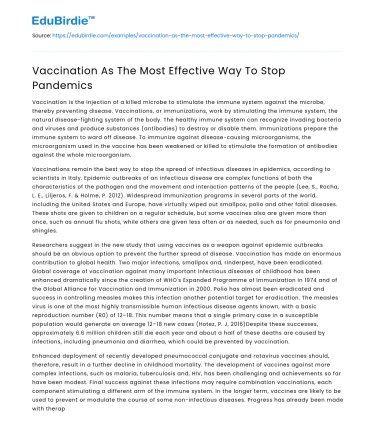Vaccination is the Injection of a killed microbe to stimulate the immune system against the microbe, thereby preventing disease. Vaccinations, or immunizations, work by stimulating the immune system, the natural disease-fighting system of the body. The healthy immune system can recognize invading bacteria and viruses and produce substances (antibodies) to destroy or disable them. Immunizations prepare the immune system to ward off disease. To immunize against disease-causing microorganisms, the microorganism used in the vaccine has been weakened or killed to stimulate the formation of antibodies against the whole microorganism.
Vaccinations remain the best way to stop the spread of infectious diseases in epidemics, according to scientists in Italy. Epidemic outbreaks of an infectious disease are complex functions of both the characteristics of the pathogen and the movement and interaction patterns of the people (Lee, S., Rocha, L. E., Liljeros, F. & Holme, P. 2012). Widespread immunization programs in several parts of the world, including the United States and Europe, have virtually wiped out smallpox, polio and other fatal diseases. These shots are given to children on a regular schedule, but some vaccines also are given more than once, such as annual flu shots, while others are given less often or as needed, such as for pneumonia and shingles.
Researchers suggest in the new study that using vaccines as a weapon against epidemic outbreaks should be an obvious option to prevent the further spread of disease. Vaccination has made an enormous contribution to global health. Two major infections, smallpox and, rinderpest, have been eradicated. Global coverage of vaccination against many important infectious diseases of childhood has been enhanced dramatically since the creation of WHO's Expanded Programme of Immunization in 1974 and of the Global Alliance for Vaccination and Immunization in 2000. Polio has almost been eradicated and success in controlling measles makes this infection another potential target for eradication. The measles virus is one of the most highly transmissible human infectious disease agents known, with a basic reproduction number (R0) of 12–18. This number means that a single primary case in a susceptible population would generate on average 12–18 new cases (Hotez, P. J, 2016)Despite these successes, approximately 6.6 million children still die each year and about a half of these deaths are caused by infections, including pneumonia and diarrhea, which could be prevented by vaccination.
Enhanced deployment of recently developed pneumococcal conjugate and rotavirus vaccines should, therefore, result in a further decline in childhood mortality. The development of vaccines against more complex infections, such as malaria, tuberculosis and, HIV, has been challenging and achievements so far have been modest. Final success against these infections may require combination vaccinations, each component stimulating a different arm of the immune system. In the longer term, vaccines are likely to be used to prevent or modulate the course of some non-infectious diseases. Progress has already been made with therapeutic cancer vaccines. Vaccines based on tumor antigens that are expressed differentially between tumors and normal cells and can stimulate immunity, and for which safety and efficacy have been proved in animal models and to the extent possible in therapeutic clinical trials, should be considered prime candidates for prophylactic cancer vaccines (Finn, O. J, 2014) .future potential targets include addiction, diabetes, hypertension and, Alzheimer's disease.
All things considered, it is important to note that vaccines are among the most effective prevention tools available to clinicians as they prevent morbidity and mortality caused by epidemics and pandemics. In the last century, vaccination has been the most effective medical intervention to reduce death and morbidity caused by infectious diseases. It is believed that vaccines save at least 2–3 million lives per year worldwide. Smallpox has been eradicated and polio has almost disappeared worldwide through global vaccine campaigns. Most of the viral and bacterial infections that traditionally affected children have been drastically reduced thanks to national immunization programs in developed countries.
REFERENCES
- Lee, S., Rocha, L. E., Liljeros, F., & Holme, P. (2012). Exploiting temporal network structures of human interaction to effectively immunize populations. PloS one, 7(5).
- Finn, O. J. (2014). Vaccines for cancer prevention: a practical and feasible approach to the cancer epidemic. Cancer immunology research, 2(8), 708-713.
- Hotez, P. J. (2016). Texas and its measles epidemics. PLoS medicine, 13(10).






 Stuck on your essay?
Stuck on your essay?

